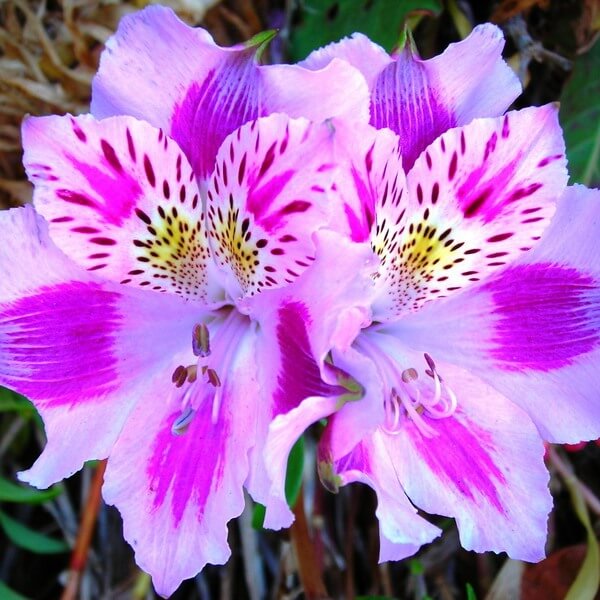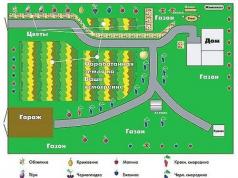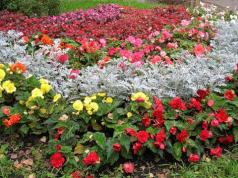Growing an indoor garden requires a lot of effort and time to organize the care of green pets. But in addition to this, the florist must have a good understanding of flowering beauties and their varieties. After all, there are representatives of the flora who are undeservedly ignored. We are talking about Alstroemeria domestica flowers, which belongs to the Alstroemeriaceae family. Look at the photo of alstroemeria flowers - they illustrate the richness of shades and the special exquisite beauty of the buds: 
“Alstroemeria” in the language of flowers means “cute”, “lovely”, “desire to make a compliment”. A bouquet of this type of flowers is usually given to those girls who are in constant motion.
The name of the flower was given by Carl Linnaeus in honor of the Swedish botanist Claes Alströmer. The plant can be found wild in South America and in the cold regions of the Andes Mountains.
On one stem of the plant you can find approximately 10-15 small flowers. Their size is 5 centimeters in diameter. When you look at the flowers, you get the impression that they have specks and lines drawn on them. Flowers have a variety of colors: yellow, orange, pink, red, crimson, white, burgundy, purple.
The leaves on the flower are narrow, medium-sized, and green. The flower reaches one and a half meters in height. This plant blooms almost the entire summer period, starting in mid-June. It is often grown specifically for cutting, since a bouquet of them can last for a very long time - up to two weeks.
At home, alstroemeria is grown as an evergreen crop, the flowering of which depends on the time of sowing the seeds. Well, and another portion of colorful photos of various varieties and cultivars:

Growing home alstroemeria and caring for the plant
Alstroemeria prefers moderate temperatures. In summer, room temperature will be enough, but no more and no less than 20-22 degrees Celsius, and in winter - 13-15 degrees Celsius, minimum - 8 degrees Celsius, despite the fact that the flower can withstand even slight frosts. But they all equally do not tolerate heat. Please note that at temperatures above 28 degrees Celsius, the plant freezes in growth, quickly drops flowers, and fades. Too high an air temperature in winter is an obstacle to the formation of buds on a flower, and accordingly the plant will not be able to bloom. Growing homemade alstroemeria requires regular air spraying and protection from dry air from heating devices getting on its buds. Under the influence of dry air, all foliage and accumulated color may be shed.
The flower is light-loving, and in no way can it be classified as a plant that tolerates shaded places, however, if in autumn and winter it can be placed on a window located on the south side, then in spring and summer it requires shading during the daytime. Caring for the home alstroemeria plant includes regular watering and fertilization with a predominance of potassium and phosphorus. With a high percentage of nitrogen, excessive growth of green mass and lack of buds may be observed. 


In order for the plant to bloom well, the day must be at least 14 hours long, so the flower is illuminated with fluorescent lamps.
In spring and summer, it is recommended to water regularly, but not abundantly. The soil should have time to dry before subsequent watering. In winter, watering should be limited. The flower does not tolerate stagnation of water in the roots or excess moisture, but dry soil will not lead to anything good. During the growing season, it is advisable to water the plant in such a way that the soil is always slightly moist. By the way, water for irrigation should be soft and free of chlorine.
It is recommended to fertilize Alstroemeria flowers, but it is necessary to monitor the nitrogen content; there should not be a lot of it. Transplantation... as for it, it is recommended to replant the flower every year in the spring. The soil should consist of leaf soil, peat, humus, perlite and pine bark in a ratio of 2:1:1:1:1. The acidity of the soil should be weak. Drainage is required.
Look at the photo of alstroemeria flowers, which are properly and regularly cared for:

Growing alstroemeria from seeds in a pot
The alstroemeria flower propagates by seeds or by dividing the rhizome. Seeds should be sown in February. And in May you can transplant them into open ground. The soil must contain peat. It is recommended to stratify the seeds at a temperature of 2 to 4 degrees Celsius for one or two months, later the temperature should be increased to 20-25 degrees Celsius.
Growing alstroemeria from seeds in seedlings allows you to obtain planting material for decorating the garden and windowsill. Such plantings look great on balconies and loggias. This type of plant prefers warmth and moisture, so before you start germinating the seeds, you should definitely soak them in water for at least 5-6 hours. Afterwards, it is recommended to plant them in a plastic container or in a wooden tray, which should be pre-filled with a mixture of river sand and leaf soil. Moreover, a separate hole is formed for each seed, and the distance between them should be at least three centimeters. After you have planted the seeds, sprinkle them with substrate and water them well. Later, cover the container with plastic wrap. You can remove the film no more than once a day for a couple of minutes. 

The place where the trays with seedlings are located should be warm and lit. Under the film, the air temperature should be 22 degrees Celsius, otherwise the seeds will not sprout. If all the above conditions are met, the seeds will produce seedlings in a week or 10 days. 

After about two weeks, when you notice 3-4 leaves on young plants, they should be hardened off, gradually increasing the time they remain without a protective film. However, this option for germinating seeds is suitable in cases where you want to leave the seedlings at home. Alstroemeria flowers in a pot will delight you with a lush bush and abundant flowering, if you choose the right container. For 1 bush, a large pot with a volume of at least 5 liters is required.
For flowers that you later plan to transfer to open ground, it is advisable to carry out the stratification procedure, that is, germination at a temperature no higher than five degrees Celsius. Of course, in such a case, no more than half of the seeds will sprout, and this will take not a week or 10 days, but 2-3 weeks. However, the resulting seedlings will be more resistant to temperature changes and will even be able to safely survive spring frosts 

During the entire growing season, do not forget to weed. In the autumn, when frosts arrive, the top part of the plant is cut off and the roots are dug up. It is recommended to dry the earthen ball so that the roots do not rot during storage. It can be stored in a cellar or basement at positive winter temperatures.
And now another photo of alstroemeria, illustrating the richness of variations in bud colors: 

Remember, when you work with a flower, it is better to use gloves, as the juice of its leaves can cause irritation on the skin. 

When alstroemeria begins to bloom, it is advisable to place it in a pot that is large in volume and size. It is recommended to place the pot close to the window.








